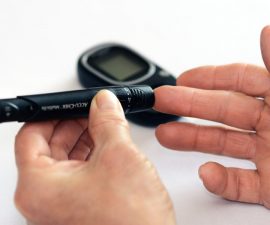… Continued …
About half of diabetics experience some form of nerve damage. Peripheral neuropathy is quite common in diabetics. Even again, diabetes is the leading cause of this nerve damage – especially in those who have had diabetes for a number of years.
The chance to reverse peripheral neuropathy in diabetics can vary. And like other diabetic complications, it’s also dependent on how well they can control their diabetes.
Careful monitoring the blood sugar levels is the key to slow the progression of the peripheral nerve damage and curb the symptoms. And if the nerve damage has not occurred, good blood sugar control does help prevent the problem.
Since early treatment is important to treat peripheral nerve damage more effectively, early diagnosis plays a key role. If you experience any unusual symptom that pinpoints to diabetic neuropathy, seek help immediately!
If the nerve is not severely impaired, it might able to be reversed. But if it the damage has become advanced, it is more difficult to reverse. For such case, the goal of the treatment is to stop the progression and prevent further damage. Again, the limited capacity of nerve to regenerate is the reason.
What are the treatments?
If high blood sugar is to blame, you need to keep it in normal target range (see also normal blood sugar targets for diabetics)! Some medications can be prescribed to help soothe and improve the symptoms, these may include:
- Pain relievers to ease and improve the pain.
- Capsaicin cream. Capsaicin is a substance found in hot peppers. It can help ease the pain by stopping the nerves delivering pain signal to the brain.
- Lidocaine plaster containing a local anesthetic. It is effective if the pain occurs in a small area.
Physiotherapy may be necessary if you have muscle weakness. You may also need medication or therapy for depression as well as counseling, because having nerve damage can make you get depressed.
Other treatments are available for other symptoms. But again, the main goal of the treatment is to keep your blood sugar as normal as possible at any given time. Many diabetics can live with the disease. There are plenty of options to keep the disease off and live long with it.
Some lifestyle measures may help, too. These include:
- Try to remain active as much as you could. Exercise can help reduce neuropathy pain.
- Eating in well-balanced diet. Nourish your nerves with plenty of essential nutrients, especially vitamin B-12 such as in eggs and fish. Include also vegetables, fruits, and whole grains. And since the problem is linked to high blood sugar, read this comprehensive guide for diabetes diet!
- Quit smoking and avoid drinking alcohol heavily! Tobacco smoke can affect blood circulation, increasing the risk of other neuropathy complications. Alcohol abuse is also often to blame, as noted before – if you drink, go with moderation!
What happen if the problem is left untreated?
Diabetic peripheral neuropathy may cause the following complications:
- Numbness may make you not feel temperature changes, causing burns and skin trauma.
- Sore or open wound that is difficult to heal, causing diabetic foot ulcer.
- The areas lacking sensation may get injured and infected without your knowing! This can also become a condition called gangrene, permanent damage (death) of part of underlying tissue or skin. In severe case, the nerve damage may lead to toes, foot, or even leg amputation.
Furthermore, advanced diabetic peripheral neuropath may also be followed with other diabetic complications. Because all of these problems link to the same cause, poorly-controlled high blood sugar. This can make anything become more difficult to cope.
The problem can affect many parts of the body. But many times, it attacks foot. Therefore, diabetics should take foot exams, at least once a year. A foot exam usually includes a check of foot muscles & bones, the skin of feet, and blood flow if necessary. You may need to regularly check your fingers, too. For more guidance, consult more with a doctor!
- http://www.diabetes.org/living-with-diabetes/complications/neuropathy/
- http://www.mayoclinic.org/diseases-conditions/peripheral-neuropathy/basics/symptoms/con-20019948
- http://www.nhs.uk/conditions/Peripheral-neuropathy/Pages/Introduction.aspx




